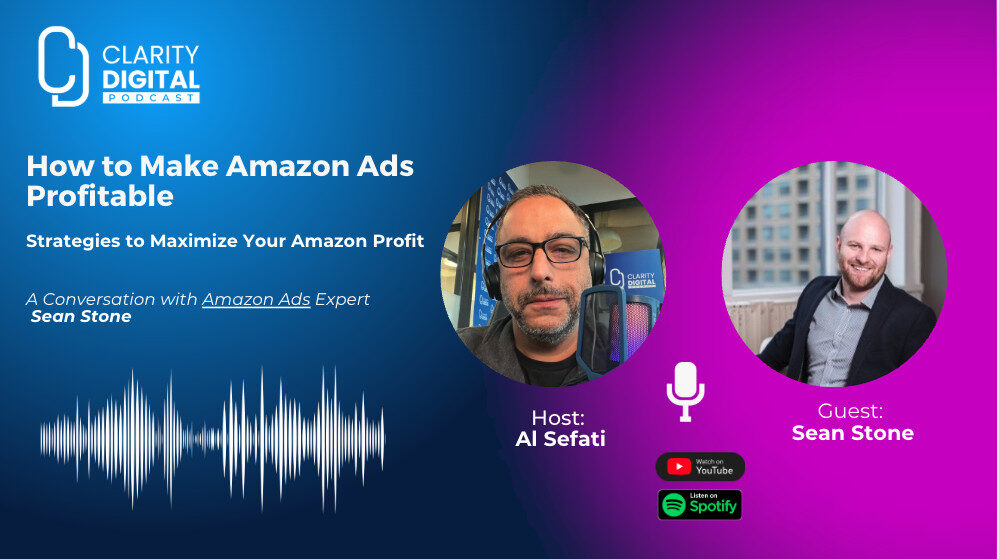When most ecommerce marketers talk about Amazon, the conversation usually focuses on the obvious—traffic, scale, and the massive opportunity of tapping into the largest online product search engine in the world. But what often gets missed is the harsh reality that advertising on Amazon isn’t just plug-and-play. It’s easy to spend money on Amazon ads. It’s much harder to spend profitably.
In this episode of the Clarity Digital podcast, I sat down with Sean Stone of Stone Goods, an Amazon adverting agency, to talk about what Amazon advertising actually involves, why so many brands waste money on the platform, and how his agency takes a “profit-first” approach to strategy that makes a real difference for brands.
Sean has been in the Amazon space since 2017, starting first as a seller before pivoting into agency work when he realized just how inefficient and under-optimized Amazon ads were. Over the years, he’s built out a methodology and framework that helps brands not just show up on Amazon—but show up profitably and at scale.
This conversation covers a lot:
- What Amazon ad agencies really do
- The evolution of Amazon’s advertising platform
- Differences between Google Ads and Amazon Ads
- How ads influence SEO and vice versa on Amazon
- Where to find reliable Amazon keyword and performance data
- Which types of brands should (and shouldn’t) be advertising on Amazon
- A full breakdown of Sean’s proprietary PAIR Framework: Promotions, Advertising, Inventory, and Rankability
- Where reviews, TikTok, and external traffic fit into your Amazon strategy
- When (and when not) to invest in influencer marketing
- What CMOs should know before launching their products on Amazon
If you’re in eCommerce or advising a brand that’s on the fence about Amazon, or struggling to make sense of Amazon ads after years of running Google or Meta campaigns, you’ll find a lot of insight in the video below:
Podcast Summary and Key Take Aways
For Amazon sellers, e-commerce businesses, and online retailers, mastering Amazon Ads can be a game-changer. While many businesses rely on the platform’s visibility to attract customers, few know how to run ads that are profitable. Amazon offers a tremendous opportunity as the default marketplace for millions of shoppers, but it also presents unique challenges due to its complexity and competitive nature.
This guide explores how Amazon Ads work, why they’re vital for e-commerce growth, and actionable strategies to make your ads more profitable. If you’ve been wondering how to leverage Amazon Ads to scale your business effectively, keep reading.
How Amazon Ads Work
When shoppers browse Amazon, they’re likely unaware that many of the results they see are actually sponsored ads. Amazon Ads operate on a pay-per-click (PPC) model, where advertisers bid on keywords relevant to their products. Winning bids determine ad placements, which can appear in various formats like search result pages or product pages.
Unlike platforms like Google, Amazon’s unique selling point is that users are already deep in the purchase funnel. They’re on Amazon because they intend to buy.
But here’s the challenge: while Amazon makes it easy to create ads, running these ads profitably is another story. That’s where strategy comes into play, as tools, metrics, and methodologies are key factors in turning visibility into revenue.
Why Amazon Ads Matter for E-Commerce
Amazon is no longer just a retail platform; it’s the world’s leading product search engine. Studies show that over 63% of product searches start on Amazon, making it essential for e-commerce businesses to have a presence on the platform.
Here’s how great Amazon Ads can directly impact your business:
- Boost Discoverability: Reach shoppers searching for products like yours.
- Improve Organic Rankings: Amazon rewards products with increased visibility when their ads convert well, leading to a blend of sponsored and organic traffic.
- Higher Conversion Rates: Amazon boasts conversion rates higher than typical e-commerce platforms.
- Revenue Growth: Smart, optimized ads enable profitable scaling without wasted ad spend.
The Challenges of Profitability with Amazon Ads
While the potential of Amazon Ads is enormous, running them profitably comes with hurdles:
- Complex Auction System: You’re bidding for ad placements, and without careful management, costs can skyrocket.
- Rising Competition: Amazon Ads growth means increased competition, leading to higher cost-per-click (CPC).
- Lack of Transparency: Understandably, Amazon doesn’t disclose every factor that influences ad ranks or organic traffic boosts from ads.
- Wasted Spend: Without proper optimization, ad spend can go to keywords or audiences that don’t convert effectively.
Key Strategies for Profitable Amazon Ad Campaigns
Running Amazon Ads isn’t just about creating campaigns; it’s about ongoing optimization to ensure profitability. Below are actionable strategies designed to maximize your ROI:
1. Understand Metrics Like TACoS
To succeed with Amazon Ads, keep your eye on specific KPIs like TACoS (Total Advertising Cost of Sales). This metric evaluates ad spend relative to total sales (including organic sales), giving insights into overall profitability. Adjust campaigns to improve TACoS by reducing inefficient spend and focusing on high-converting keywords.
2. Focus on Relevant Keywords
Amazon is a search-driven platform, and keywords are critical. Use tools like Helium 10 or DataRova to find the most relevant, high-converting keywords for your product category. Additionally:
- Bid aggressively on keywords where your product already has strong organic presence.
- Reduce spending on highly competitive terms that don’t yield conversions.
- Continuously adjust based on performance data to refine placements and CPC.
3. Optimize Existing Listings
Your ads might bring traffic to your listings, but if those listings are underwhelming, conversions will drop. Before ramping up campaigns, ensure:
- High-quality product images
- Engaging titles and bullet points
- Compelling product descriptions with persuasive copy
- A strategic use of keywords within your content
4. Use Promotions Wisely
Promotions and coupons are a powerful way to entice shoppers to click and purchase. While these require investing part of your margin, they can significantly boost conversion rates, leading to higher rankings on Amazon search results.
If you’re running ad campaigns, promotions can amplify their impact, turning ad traffic into buyers more effectively.
5. Cut Waste with Negative Keywords
Prevent your ads from appearing for irrelevant or low-performing search terms by using negative keywords. This simple step reduces unnecessary spend and keeps your campaigns focused on what drives actual sales.
6. Capitalize on Amazon’s Data
Leverage Amazon’s Search Query Performance Report, available via Brand Analytics. This first-party data offers deep insights into how your products perform for specific search terms, helping you target those that deliver maximum ROI.
If you’re not registered for Amazon’s Brand Registry (a requirement for access), consider applying for it right away to unlock these valuable tools.
7. Test Low-Cost Campaigns
Running campaigns with strict CPC caps can help you uncover hidden opportunities. Invest in test campaigns targeting highly profitable but less competitive keywords to build incremental revenue for your business.
8. Think Beyond Amazon
Although Amazon Ads focus on internal advertising, external traffic can also be a game-changer. Platforms like TikTok or Google can funnel qualified buyers to your Amazon listings. However, ensure the traffic is intent-driven, as conversion-friendly visitors can improve your overall rankings.
Amazon Ads in the Bigger E-commerce Picture
E-commerce businesses often wonder if Amazon advertising aligns with their goals, especially when operating DTC websites. The short answer? If you sell products, an Amazon presence is almost non-negotiable. Shoppers head to Amazon to find brands they’ve researched elsewhere, and if you’re not there, competitors can intercept these potential customers.
Amazon advertising, when done right, is less about competing with your DTC channel and more about expanding your reach across multiple touchpoints.
Tools You Need for Amazon Success
Efficiency in managing Amazon Ads requires the right tools. Here are some top recommendations:
- Helium 10 (Industry Standard) – A comprehensive tool for keyword research, competitor analysis, and tracking rankings.
- DataRova (Affordable Alternative) – Budget-friendly with robust features like market insights and product tracking.
- Search Query Performance Report (Amazon’s Own Data) – A must-have for optimizing ad and SEO strategies with first-party insights.
- Jungle Scout & DataDive (Honorable Mentions) – Valuable options for beginner to intermediate advertisers.
A Framework for Scalable Profitability
To consistently scale and succeed with Amazon Ads, businesses like Stone Goods Agency follow structured methodologies like the PAIR Framework:
- Promotions (P): Leverage sales, coupons, and promotions to improve conversion rates.
- Advertising (A): Continuously refine ad campaigns with keyword focus and budget optimization.
- Inventory (I): Align promotional and advertising strategies with inventory levels to prevent stockouts.
- Rankability (R): Prioritize resources to products most likely to rank well for high-value keywords.
Build Your Amazon Advantage
Amazon has evolved into a powerhouse platform for e-commerce, but operating profitably requires a clear strategy. Whether you’re a DTC brand expanding your presence or a seasoned Amazon seller optimizing your store, there are endless opportunities to grow.





